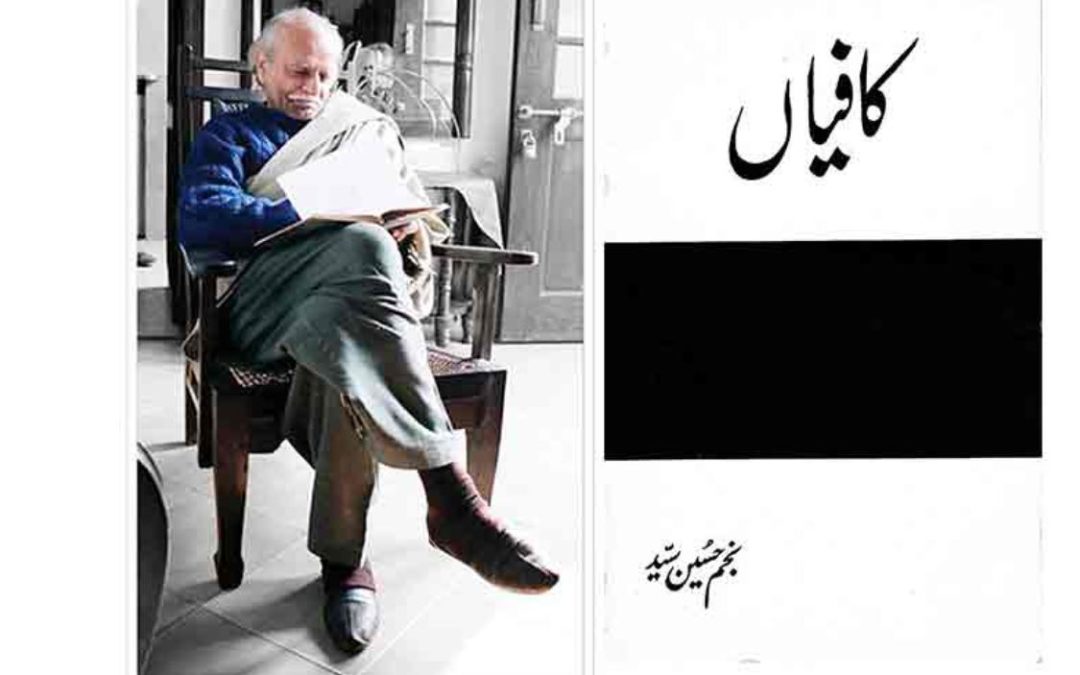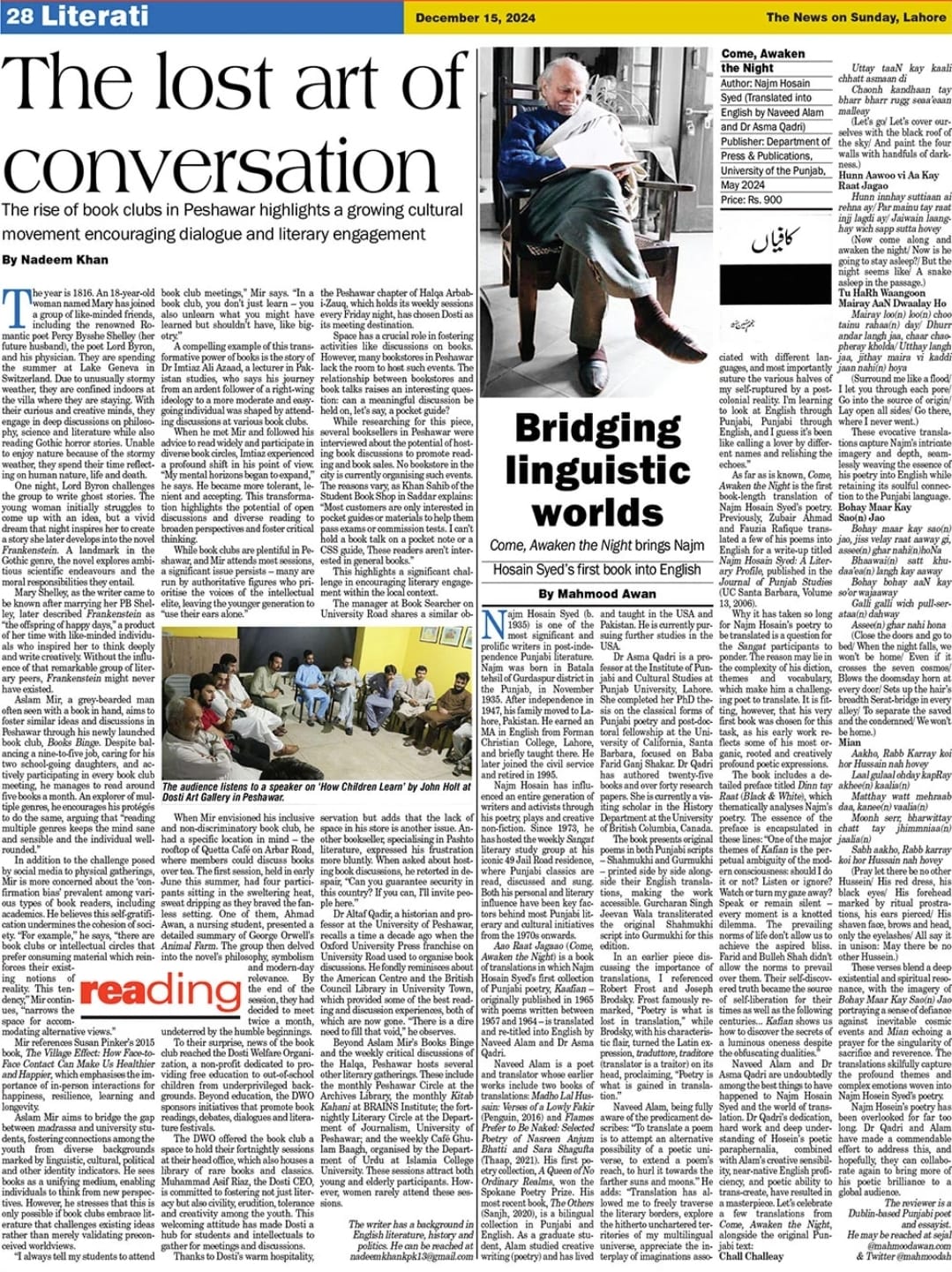Mahmood Awan (The News on Sunday, 15th December 2024)
Najm Hosain Syed (b. 1935) is one of the most significant and prolific writers in post-independence Punjabi literature. Najm was born in Batala tehsil of Gurdaspur district in the Punjab, in November 1935. After independence in 1947, his family moved to Lahore, Pakistan. He earned an MA in English from Forman Christian College, Lahore, and briefly taught there. He later joined the civil service and retired in 1995.
Najm Hosain has influenced an entire generation of writers and activists through his poetry, plays and creative non-fiction. Since 1973, he has hosted the weekly Sangat literary study group at his iconic 49 Jail Road residence, where Punjabi classics are read, discussed and sung. Both his personal and literary influence have been key factors behind most Punjabi literary and cultural initiatives from the 1970s onwards.
Aao Raat Jagaao (Come, Awaken the Night) is a book of translations in which Najm Hosain Syed’s first collection of Punjabi poetry, Kaafian – originally published in 1965 with poems written between 1957 and 1964 – is translated and re-titled into English by Naveed Alam and Dr Asma Qadri.
Naveed Alam is a poet and translator whose earlier works include two books of translations: Madho Lal Hussain: Verses of a Lowly Fakir (Penguin, 2016) and Flames Prefer to Be Naked: Selected Poetry of Nasreen Anjum Bhatti and Sara Shagufta (Thaap, 2021). His first poetry collection, A Queen of No Ordinary Realms, won the Spokane Poetry Prize. His most recent book, The Others (Sanjh, 2020), is a bilingual collection in Punjabi and English. As a graduate student, Alam studied creative writing (poetry) and has lived and taught in the USA and Pakistan. He is currently pursuing further studies in the USA.
Dr Asma Qadri is a professor at the Institute of Punjabi and Cultural Studies at Punjab University, Lahore. She completed her PhD thesis on the classical forms of Punjabi poetry and post-doctoral fellowship at the University of California, Santa Barbara, focused on Baba Farid Ganj Shakar. Dr Qadri has authored twenty-five books and over forty research papers. She is currently a visiting scholar in the History Department at the University of British Columbia, Canada.
The book presents original poems in both Punjabi scripts – Shahmukhi and Gurmukhi – printed side by side alongside their English translations, making the work accessible. Gurcharan Singh Jeevan Wala transliterated the original Shahmukhi script into Gurmukhi for this edition.
In an earlier piece discussing the importance of translations, I referenced Robert Frost and Joseph Brodsky. Frost famously remarked, “Poetry is what is lost in translation,” while Brodsky, with his characteristic flair, turned the Latin expression, traduttore, traditore (translator is a traitor) on its head, proclaiming, “Poetry is what is gained in translation.”
Naveed Alam, being fully aware of the predicament describes: “To translate a poem is to attempt an alternative possibility of a poetic universe, to extend a poem’s reach, to hurl it towards the farther suns and moons.” He adds: “Translation has allowed me to freely traverse the literary borders, explore the hitherto unchartered territories of my multilingual universe, appreciate the interplay of imaginations associated with different languages, and most importantly suture the various halves of my self-ruptured by a post-colonial reality. I’m learning to look at English through Punjabi, Punjabi through English, and I guess it’s been like calling a lover by different names and relishing the echoes.”
As far as is known, Come, Awaken the Night is the first book-length translation of Najm Hosain Syed’s poetry. Previously, Zubair Ahmad and Fauzia Rafique translated a few of his poems into English for a write-up titled Najm Hosain Syed: A Literary Profile, published in the Journal of Punjab Studies (UC Santa Barbara, Volume 13, 2006).
Why it has taken so long for Najm Hosain’s poetry to be translated is a question for the Sangat participants to ponder. The reason may lie in the complexity of his diction, themes and vocabulary, which make him a challenging poet to translate. It is fitting, however, that his very first book was chosen for this task, as his early work reflects some of his most organic, rooted and creatively profound poetic expressions.
The book includes a detailed preface titled Dinn tay Raat (Black & White), which thematically analyses Najm’s poetry. The essence of the preface is encapsulated in these lines: “One of the major themes of Kafian is the perpetual ambiguity of the modern consciousness: should I do it or not? Listen or ignore? Watch or turn my gaze away? Speak or remain silent – every moment is a knotted dilemma. The prevailing norms of life don’t allow us to achieve the aspired bliss. Farid and Bulleh Shah didn’t allow the norms to prevail over them. Their self-discovered truth became the source of self-liberation for their times as well as the following centuries… Kafian shows us how to discover the secrets of a luminous oneness despite the obfuscating dualities.”
Naveed Alam and Dr Asma Qadri are undoubtedly among the best things to have happened to Najm Hosain Syed and the world of translation. Dr Qadri’s dedication, hard work and deep understanding of Hosein’s poetic paraphernalia, combined with Alam’s creative sensibility, near-native English proficiency, and poetic ability to trans-create, have resulted in a masterpiece. Let’s celebrate a few translations from Come, Awaken the Night, alongside the original Punjabi text:
Chall Challeay
Uttay taaN kay kaali chhatt asmaan di
Chaonh kandhaan tay bharr bharr rugg seaa’eaan malleay
(Let’s go/ Let’s cover ourselves with the black roof of the sky/ And paint the four walls with handfuls of darkness.)
Hunn Aawoo vi Aa Kay Raat Jagao
Hunn innhay suttiaan ai rehna ay/ Par mainu tay raat injj lagdi ay/ Jaiwain laanghay wich sapp sutta hovey
(Now come along and awaken the night/ Now is he going to stay asleep?/ But the night seems like/ A snake asleep in the passage.)
Tu HaRh Waangoon Mairay AaN Dwaalay Ho
Mairay loo(n) loo(n) choo tainu rahaa(n) day/ Dhurr andar langh jaa, chaar chao-pheray kholda/ Utthay langh jaa, jithay maira vi kaddi jaan nahi(n) hoya
(Surround me like a flood/ I let you through each pore/ Go into the source of origin/ Lay open all sides/ Go there, where I never went.)
These evocative translations capture Najm’s intricate imagery and depth, seamlessly weaving the essence of his poetry into English while retaining its soulful connection to the Punjabi language.
Bohay Maar Kay
Sao(n) Jao
Bohay maar kay sao(n) jao, jiss velay raat aaway gi, assee(n) ghar nahi(n)hoNa
Bhaawai(n) satt khudaa’ea(n) langh kay aaway
Bohay bohay aaN kay so’or wajaaway
Galli galli wich pull-serataa(n) dahway
Assee(n) ghar nahi hona
(Close the doors and go to bed/ When the night falls, we won’t be home/ Even if it crosses the seven cosmos/ Blows the doomsday horn at every door/ Sets up the hair’s breadth Serat-bridge in every alley/ To separate the saved and the condemned/ We won’t be home.)
Mian
Aakho, Rabb Karray koi hor Hussain nah hovey
Laal gulaal ohday kapRay akhee(n) kaalia(n)
Matthay watt mehraab daa, kanee(n) vaalia(n)
Moonh serr, bharwittay chatt tay jhimmniaa(n) jaalia(n)
Sabh aakho, Rabb karray koi hor Hussain nah hovey
(Pray let there be no other Hussein/ His red dress, his black eyes/ His forehead marked by ritual prostrations, his ears pierced/ His shaven face, brows and head, only the eyelashes/ All say it in unison: May there be no other Hussein.)
These verses blend a deep existential and spiritual resonance, with the imagery of Bohay Maar Kay Sao(n) Jao portraying a sense of defiance against inevitable cosmic events and Mian echoing a prayer for the singularity of sacrifice and reverence. The translations skilfully capture the profound themes and complex emotions woven into Najm Hosein Syed’s poetry.
Najm Hosein’s poetry has been overlooked for far too long. Dr Qadri and Alam have made a commendable effort to address this, and hopefully, they can collaborate again to bring more of his poetic brilliance to a global audience.
Come, Awaken the Night
Author: Najm Hosain Syed (Translated into English by Naveed Alam and Dr Asma Qadri)
Publisher: Department of Press & Publications, University of the Punjab, May 2024
Price: Rs. 900
Published on 15th December 2024 in The News on Sunday.
https://www.thenews.com.pk/tns/detail/1261202-linguistic-worlds


